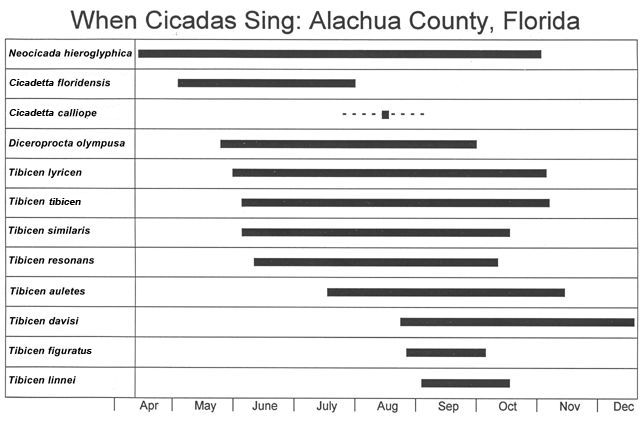It is very interesting that cicadas in Florida appear every year, unlike their appearances further north in the rest of the eastern United States where periodical cicadas appear in hordes every 13 or 17 years.
Newcomers to Florida are often surprised by the sound of cicadas year in year out. For many Floridians, however, the loud calls of cicadas are a soundtrack for a multitude of Summer memories. The sound is so prevalent during those hot muggy months that their calls fall into the background and we no longer pay attention. But they are there.
This link takes you to recordings of calls from twelve different species of cicadas tracked in Alachua County from April to December.

The first species begin to sing in April and are joined month by month util the last species sings alone in December.
How do Cicadas Sing?
Cicadas produce their calls with paired drum-like structures on the sides of the lower body segments. Each drum or timbal is an area of flexible cuticle surrounded by a stiff rim and crossed top to bottom by a series of narrow stiff ribs and a stiff larger plate to the ribs. They are literally little drum heads.
A muscle that is attached to the timbal plate causes the ribs to pop inward when it contracts and allows the ribs to pop outward when it relaxes. This produces a loud sound when moving both in and out, or for some cicadas, only inward. Internally each timbal is backed by an air sac that frees it to vibrate with each pop of its ribs.
Cicada Calls of Love and Protest
Only males have timbals (except for one Australian genus). All cicadas can produce soft sounds with wing flips, and often do so in mild disturbance situations. Most sounds made by males are calling songs, which are species specific and serve to attract sexually responsive females to the calling male.
When a predator, such as a bird or small mammal, seizes or attempts to seize a male cicada, the cicada emits a protest song or disturbance squawk, which may startle the predator into allowing the squawker to escape. In some species, when a male is in visual or physical contact with a female, he emits quieter courtship songs. Females of several species are known to answer a courting male with wing flips that encourage the male.
Cicada calling songs might sound like power tools. Strange but true, some people have reported that female cicadas have responded to lawnmowers. This brings up some funny cartoon images in my mind!
Why Don’t We See Cicadas?
While we hear them all the time, cicadas are rarely seen or captured. You will however, from time to time, see their cast-off skeletons on tree trunks for shrubs.
All cicada nymphs live in underground burrows, where they feed the sap from roots of grasses and plants. They molt four times while underground and on the last one it crawls to the surface and a short distance up a tree trunk or herb stem. Anchored there it molts for the fifth time and becomes an adult leaving its last molted shell to hang or drop there.
Adult cicadas are strong fliers, visually alert and live mostly in trees. The adult males call in order to attract that female for mating after which she lays her eggs in the woody tissue of small branches. Their lives are brief – seldom more than a few weeks.
On the positive side, cicadas do not bite or sting and provide food for many kinds of wildlife, including birds, small mammals, and other insects.
The Diversity of Cicadas in Florida
In case you are interested, there are 19 cicada species known from Florida. They have colorfully descriptive names and distinct call patterns. Here is a list from the University of Florida Entomology Department.
Small cicadas
little brown cicada (cicadetta calliope)
little green cicada (cicadetta floridensis)
Medium-size cicadas
Olympic cicada (Diceroprocta olympusa) Partial to pines and waste fields; song a continuous droning buzz.
seaside cicad (Diceroprocta viridifascia) Coastal; song is a continuous slower and louder zit zit zit zit.
hieroglyphic cicada (Neocicada hieroglyphica) Partial to oaks; first species to be heard in spring; song starts with a sequence of progressively softer whiney bursts and ends with an even whine.
Large cicadas
Keys cicada (Diceroprocta biconical) Florida Keys; song a loud continuous high-pitched, metallic buzz.
dusk-calling cicada (Tibicen auletes)
dog-day cicada (Tibicen canicularis)
swamp cicada (Tibicen chloromera)
Davis’s dog-day cicada (Tibicen davisi)
fall dog-day cicada (Tibicen figurate)
Linne’s cicada (Tibicen linnei)
lyric cicada (Tibicen lyricen)
scissor-grinder cicada (Tibicen pruinosa)
resonate cicada (Tibicen resonans)
similar cicada (Tibicen similaris)
There’s no need to call us about cicadas, but we sure hope you think to call us at Heath Pest Control when something else pops up. You can also request a visit at this link.

